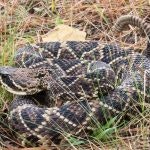Living With Snakes

January 15, 2023 By Katie Roundtree
Living in Florida, you have no doubt seen snakes in your travels. A fear of snakes, or Ophidiophobia, is common in many people. Interactions between people and venomous snakes in residential areas are much less common than those involving non-venomous species. The risk of snakebite (venomous or non-venomous) is minimal. Snakes defend themselves primarily by fleeing but may bite if captured or harmed. However, biting is not a sign that they are dangerous; it is the only way most snakes have to defend themselves.
Depending on your point of view, Florida is blessed or cursed with a rich diversity of snakes. Forty-four species of snakes are found in every conceivable habitat, from coastal mangroves and saltmarshes to freshwater wetlands and dry uplands. Many species thrive in residential areas.
Most snakes you encounter are likely to be non-venomous. By recognizing snakes and understanding their habits, you can take a more relaxed attitude toward them and appreciate them as an integral part of Florida’s wildlife. Northern is thrilled that greenways and preserves within our area can support a broad diversity of wildlife, including snakes.
Only six of Florida’s 44 snake species are venomous, the eastern coral snake, the southern copperhead, the cottonmouth, the eastern diamondback rattlesnake, the timber rattlesnake, and the dusky pygmy rattlesnake. Out of the six, just four of them live south of Gainesville. Most Florida snakes are harmless and play a key role by keeping rodent populations under control. Even the venomous species are not particularly dangerous unless stepped on or otherwise provoked.
Eastern diamondback rattlesnakes are solitary animals that are effective ambush predators. Since these snakes are cold-blooded, they bask in the sun to regulate their body temperatures. This species uses gopher tortoise burrows, armadillo holes, stump holes and root channels to avoid inclement weather. These shelters keep them warm when air temperatures become too cold for surface activity. While foraging, rattlesnakes use vegetation for cover, relying on camouflage to conceal them. They are ambush predators, meaning they sit and wait in a coiled position for prey to cross their path. They use their thermal pits to help them locate warm-blooded prey. These snakes mostly eat mammals such as mice, rabbits, rats, and squirrels and occasionally eat ground-dwelling birds.
When camouflage fails, and they feel threatened, the snake will begin to puff itself up to look larger and more intimidating. Eventually, it may rattle its tail to scare off the threat. Rattlesnakes, like many animals, would prefer to leave a dangerous situation silently. When given the opportunity, rattlesnakes will flee from human encounters. If you see a rattlesnake in the wild, it is best to give it space or let it slither away.
What should you do when you come upon a snake? Just stand back and observe it. Snakes don’t purposefully position themselves to frighten people. They’d much rather avoid encounters and will usually flee.
There is no good reason to kill a snake except in the unlikely situation of a venomous snake posing immediate danger to people or pets. Snakes usually bite people only if assaulted; it’s their only means of self-defense. Even a venomous snake in the woods or crossing the road poses no threat and should be left alone. Also, large snakes travel in large areas, so one you see in your yard today may be far away tomorrow. When the temperature is cooler or cold the snakes are very slow to move and mostly harmless.
The frequent sighting of snakes near dwellings or outbuildings may indicate the presence of rodents. Removing brush, lumber, or other debris accumulations will discourage rodents and snakes. Homeowners should also police rodent food sources like chronically spilled bird seed under feeders or pet food scraps regularly.
If you are bitten by a venomous snake, call 911 immediately. Miami Dade Fire Rescue maintains the largest and only antivenom bank for public use in the United States and provides antivenom to hospitals in the tri-county area, but also deploys antivenom via emergent shipping to out-of-area hospitals. If you have a snake, Africanized honey bee or large or small animal emergency or nuisance, 911 will dispatch the Venom Response Team.
Attempting to harass, handle, or kill snakes significantly increases your chances of being bitten. It is best to adopt a “leave it be” attitude for all snakes. This attitude can also help to prevent the needless killing of harmless snake species. If you are not 100% sure of the identity of a snake, “leave it be.”
Information obtained from Florida’s Fish and Wildlife Conservation Commission at: http://myfwc.com/conservation/you-conserve/wildlife/snakes/
